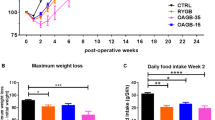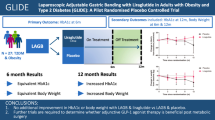Abstract
AIM: To determine whether visceral fat reduction in connection with bariatric surgery could improve weight loss and metabolic profile of obese subjects.
PATIENTS AND METHODS: In a one-center, randomized and controlled pilot trial we assigned 50 subjects with severe obesity (body mass index >35 kg/m2) to either adjustable gastric banding (AGB) alone (11 men and 14 women), or AGB plus surgical removal of the total greater omentum (11 men and 14 women). The patients were followed at regular intervals for 2 y and examined at 0 and 24 months with respect to body composition and metabolic profile.
RESULTS: No significant differences between control and omentectomized patients were observed at baseline. The removed greater omentum constituted 0.8±0.4% (mean±s.d.) of total body fat. At 2 y follow-up there was an expected decrease in body weight and an improvement in metabolic profile in both groups. Although omentectomized subjects tended to lose more weight than control subjects the difference was not statistically significant and changes in waist-to-hip ratio and saggital diameter did not differ between groups. However, the improvements in oral glucose tolerance, insulin sensitivity and fasting plasma glucose and insulin were 2–3 times greater in omentectomized as compared to control subjects (P from 0.009 to 0.04), which was statistically independent of the loss in body mass index. No differences in blood lipids between the groups were recorded. No adverse effects related to omentectomy were observed.
CONCLUSIONS: Omentectomy, when performed together with AGB, has significant positive and long-term effects on the glucose and insulin metabolic profiles in obese subjects.
This is a preview of subscription content, access via your institution
Access options
Subscribe to this journal
Receive 12 print issues and online access
$259.00 per year
only $21.58 per issue
Buy this article
- Purchase on Springer Link
- Instant access to full article PDF
Prices may be subject to local taxes which are calculated during checkout

Similar content being viewed by others
References
Modkad AH, Serdula MK, Dietz WH, Boeman BA, Marks JS, Koplan JP . The spread of the obesity epidemic in the United States, 1991–1998 JAMA 1999 282: 1519–1522.
Björntorp P . ‘Portal’ adipose tissue as a generator of risk factors for cardiovascular disease and diabetes Atherosclerosis 1990 10: 493–496.
Kissebah AH, Krakower GR . Regional adiposity and morbidity Physiol Rev 1994 74: 761–811.
Lemieux S, Després JP . Metabolic complications of visceral obesity: contribution of the aetiology of type 2 diabetes and implications for prevention and treatment Diabetes Metab 1994 20: 375–393.
Fujioka S, Matsuzawa Y, Tokunaga K et al. Improvement of glucose and lipid metabolism associated with selective reduction of intra-abdominal visceral fat in premenopausal women with visceral fat obesity Int J Obes 1990 15: 853–859.
Riches FM, Watts GF, Hua J, Stewart GR, Naoumova RP, Barrett PHR . Reduction in visceral adipose tissue is associated with improvement in apolipoprotein B-100 metabolism in obese men J Clin Endocrinol Metab 1999 84: 2854–2861.
Arner P . All fat is not alike Lancet 1998 351: 1301–1302.
Frayn KN, Williams CM, Arner P . Are increased plasma non-esterified fatty acid concentrations a risk marker for coronary heart disease and other chronic diseases? Clin Sci 1996 90: 243–253.
Mohamed-Ali V, Pinkney JH, Coppack SW . Adipose tissue as an endocrine and paracrine organ Int J Obes Relat Metab Disord 1998 22: 1145–1158.
Bolinder J, Lithell H, Skarfors E, Arner P . Effects of obesity, hyperinsulinemia, and glucose intolerance on insulin action in adipose tissue of sixty-year-old men Diabetes 1986 35: 282–290.
Hirst S, Phillips DI, Vines SK, Clark M, Hales CN . Reproducibility of the short insulin tolerance test Diabetes Med 1993 10: 839–842.
Lindheim SR, Buchanan TA, Duffy DM, Vijod MA, Kojima T, Stanczyk FZ, Lobo RA . Comparison of estimates of insulin sensitivity in pre- and postmenopausal women using the insulin tolerance test and the frequently sampled intravenous glucose tolerance test J Soc Gynecol Invest 1994 1: 150–154.
Gelding SV, Robinson S, Lowe S, Niththyananthan R, Johnston DG . Validation of the low dose short insulin tolerance test for evaluation of insulin sensitivity J Clin Endocrinol 1994 40: 611–615.
Bonora E, Moghetti P, Zancanaro C, Cigolini M, Querena M, Cacciatori V, Corgnati A, Muggeo M . Estimates of in vivo insulin action in man: comparison of insulin tolerance tests with euglycemic and hyperglycemic glucose clamp studies J Clin Endocrinol Metab 1989 68: 374–378.
Graci S, Baratta R, Degano C, Luppa A, Vigneri R, Frittittta L, Trischitta V . The intravenous insulin tolerance test is an accurate method for screening a general population for insulin resistance and related abnormalities J Endocrinol Invest 1999 22: 472–475.
Lönnqvist F, Nordfors L, Jansson M, Thörne A, Schalling M, Arner P . Leptin secretion from adipose tissue in women. Relationship to plasma levels and gene expression J Clin Invest 1997 99: 2398–2404.
Eriksson P, Reynisdottir S, Lönnqvist F, Stemme V, Hamsten A, Arner P . Adipose tissue secretion of plasminogen activator inhibitor-I in non-obese and obese individuals Diabetologia 1998 41: 65–71.
Lövig T, Haffner JFW, Kaaresen R, Nygaard K, Stadaas JO . Gastric banding for morbid obesity: five years follow up Int J Obes Relat Metab Disord 1993 17: 453–457.
Näslund E, Backman L, Granström L, Stockeld D . Seven year results of vertical banded gastroplasty for morbid obesity Eur J Surg 1997 163: 281–286.
DeFronzo RA, Bonadonna RC, Ferrannini L . Pathogenesis of NIDDM. A balanced overview Diabetes Care 1992 15: 318–368.
Kissebah AH . Insulin resistance in visceral obesity Int J Obes 1991 15: 109–115.
Despres JP . Abdominal obesity as important component of insulin-resistance syndrome Nutrition 1993 9: 452–459.
Del Prato S . Measurement of insulin resistance in vivo Drugs 1999 58: S3–S6.
Bujalska IJ, Kumar S, Stewart PM . Does central obesity reflect ‘Cushing's disease of the omentum’? Lancet 1997 349: 1210–1213.
Barzilai N, She L, Liu B-Q et al. Surgical removal of visceral fat reverses hepatic insulin resistance Diabetes 1999 48: 94–98.
Berntorp E, Berntorp K, Brorson H, Frick K . Liposuction in Dercum's disease: impact on haemostatis factors associated with cardiovascular disease and insulin sensitivity J Intern Med 1998 243: 197–201.
Legato MJ . Gender-specific aspects of obesity Int J Fertil Women Med 1997 42: 184–197.
Acknowledgements
The invaluable help of research nurse Britt Marie Leijonhufvud is greatly appreciated. We are grateful for statistical advise from Anna Hagman.
This study was supported by grants from the Swedish Medical Research Council, the Swedish Diabetes Foundation, the Söderberg Foundation, the Novo Nordic Foundation and the Swedish Heart and Lung Association.
Author information
Authors and Affiliations
Corresponding author
Rights and permissions
About this article
Cite this article
Thörne, A., Lönnqvist, F., Apelman, J. et al. A pilot study of long-term effects of a novel obesity treatment: omentectomy in connection with adjustable gastric banding. Int J Obes 26, 193–199 (2002). https://doi.org/10.1038/sj.ijo.0801871
Received:
Accepted:
Published:
Issue Date:
DOI: https://doi.org/10.1038/sj.ijo.0801871
Keywords
This article is cited by
-
Potential confounders of the obesity paradox in older patients following transcatheter aortic valve replacement
European Geriatric Medicine (2023)
-
Mechanisms linking bariatric surgery to adipose tissue, glucose metabolism, fatty liver disease and gut microbiota
Langenbeck's Archives of Surgery (2023)
-
The relation of omentin gene expression and glucose homeostasis of visceral and subcutaneous adipose tissues in non-diabetic adults
Molecular Biology Reports (2022)
-
Peripancreatic adipose tissue protects against high-fat-diet-induced hepatic steatosis and insulin resistance in mice
International Journal of Obesity (2020)
-
CD90 serves as differential modulator of subcutaneous and visceral adipose-derived stem cells by regulating AKT activation that influences adipose tissue and metabolic homeostasis
Stem Cell Research & Therapy (2019)



